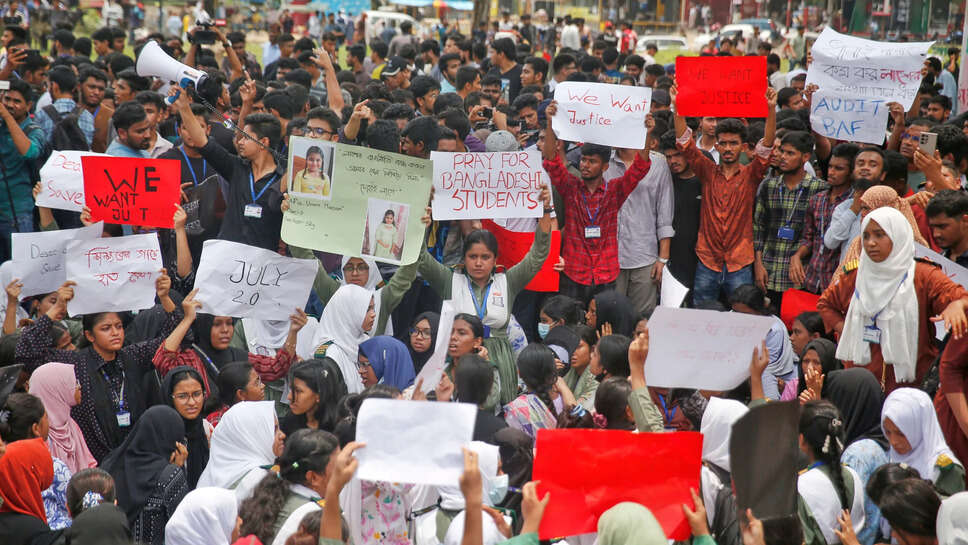Tragedy in the classroom: jet crash sparks anger among Bangladesh’s youth

A horrifying tragedy unfolded in Bangladesh as a fighter jet belonging to the nation’s air force crashed directly into a school campus, killing at least 32 people — most of them students. The nation has plunged into deep mourning, but grief is quickly transforming into rage as thousands of students have taken to the streets demanding justice, answers, and accountability.
The fatal crash has not only exposed lapses in aviation safety but also opened up long-standing tensions between military infrastructure and public safety, especially in densely populated urban centers.
🕯️ A Morning Turned Nightmare
The incident occurred during regular school hours in the capital’s outskirts. Students were in their classrooms when the aircraft — a training jet conducting routine drills — lost control mid-air. Within seconds, the jet veered off course, plummeted rapidly, and struck the school building with a deafening explosion.
The impact caused an immediate collapse of two wings of the school. Fire and thick smoke engulfed the classrooms. Teachers and children had no time to escape. Emergency services arrived within minutes, but the scene was already one of devastation. Parents rushed to the school, some collapsing in grief upon discovering the loss of their children.
Initial reports confirmed 32 fatalities and over 100 injured — many of them in critical condition.
😡 A Nation in Grief — and in Fury
As news spread, students in schools and colleges across Bangladesh began spontaneous walkouts. Protesters chanted slogans against negligence and demanded a full public inquiry into how such a catastrophic error could have occurred.
Several student unions issued strongly worded statements accusing the air force of “endangering civilian lives” by flying dangerously close to educational institutions. Demonstrations began in Dhaka and rapidly spread to cities like Chittagong, Sylhet, Rajshahi, and Khulna.
Placards carried by angry youth read:
-
"Our schools are not crash zones."
-
"Justice for the 32 lost souls."
-
"Who allowed jets over our classrooms?"
🏫 Why Was a Jet Flying Over a School?
That question has now become the center of national conversation. According to aviation protocols, military training routes are supposed to avoid residential or educational zones. However, this jet was reportedly performing low-altitude drills — raising questions about compliance and oversight.
Many parents are now asking: Why was no warning issued? Why were school authorities not informed of any aerial activity? And why is military training occurring near public infrastructure?
🎓 The Students Lead the Charge
The most striking response has come from Bangladesh’s youth. Campuses across the nation turned into protest grounds, with candlelight vigils, protest marches, and human chains.
University and school students have called for:
-
An independent, civilian-led investigation into the crash
-
Public release of flight control data and pilot logs
-
Compensation for victims’ families
-
Legal action against those responsible
-
Relocation of all military drills away from populated areas
The slogan “Shikkha Shantir Jonno, Juddho Noy” (Education is for peace, not war) has emerged as a rallying cry.
🚨 Government and Military Response
In a late-night address, a government spokesperson expressed deep sorrow and promised a full investigation. A day of national mourning was declared, with flags lowered across public buildings.
The air force also released a brief statement, acknowledging the crash and confirming that the pilot did not survive. They maintained that a "technical fault" had likely caused the incident and promised cooperation with investigators.
However, critics argue that both the military and civil aviation authorities have failed to act transparently in the past. The current protests reflect deeper distrust in institutional accountability.
🏥 Scenes From the Hospitals
Hospitals in Dhaka and nearby districts are overwhelmed with injured students and teachers. Volunteers and NGOs have stepped in to provide psychological support to traumatized survivors.
Parents who lost children in the crash have called for memorials to be built in their memory. “We sent our children to study, not to die in flames,” sobbed one grieving mother outside the hospital.
🔍 Calls for Reform Grow Louder
This disaster is prompting renewed debate about urban safety regulations, especially in cities like Dhaka where military bases, airstrips, schools, and homes often exist side-by-side.
Several urban planners and safety experts are demanding:
-
Clearly marked “no-fly” zones over schools and hospitals
-
Public awareness programs during drills
-
Emergency evacuation planning in schools
-
De-militarization of zones near residential areas
Students have vowed to continue protesting until permanent reforms are put in place.
🌐 International Reactions
Though no official diplomatic statements have been made yet, the tragic crash has made global headlines. Education rights advocates worldwide have condemned the loss of innocent student lives and expressed solidarity with grieving families.
Some international student organizations have offered support for protest movements, stressing that “children’s right to safety in school must never be compromised.”
🕊️ A Somber Road Ahead
The coming days are expected to witness memorial marches, mass student rallies, and likely political debates in parliament. Government committees have been formed, but protestors fear that justice will be delayed or diluted.
In the heart of Dhaka, students held a silent sit-in today with 32 chairs laid out — each bearing the name of a victim and a lit candle.
One student’s message, written in chalk on the pavement, said it all:
“We will not study in fear. We will not forget their names.”
The Bangladesh air force jet crash has scarred an entire generation. It is no longer just about an aircraft or a malfunction — it is about trust, accountability, and the right of children to learn in peace.
Whether this tragedy will lead to lasting change or fade into forgotten headlines remains to be seen. But one thing is clear — Bangladesh’s students are not staying silent. And they are determined to ensure that no school ever becomes a crash site again.
